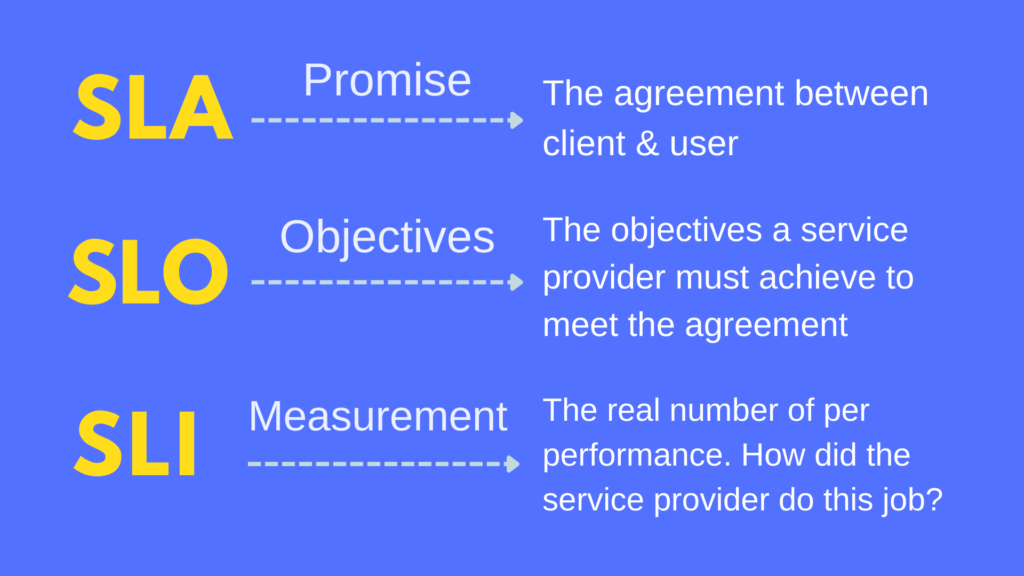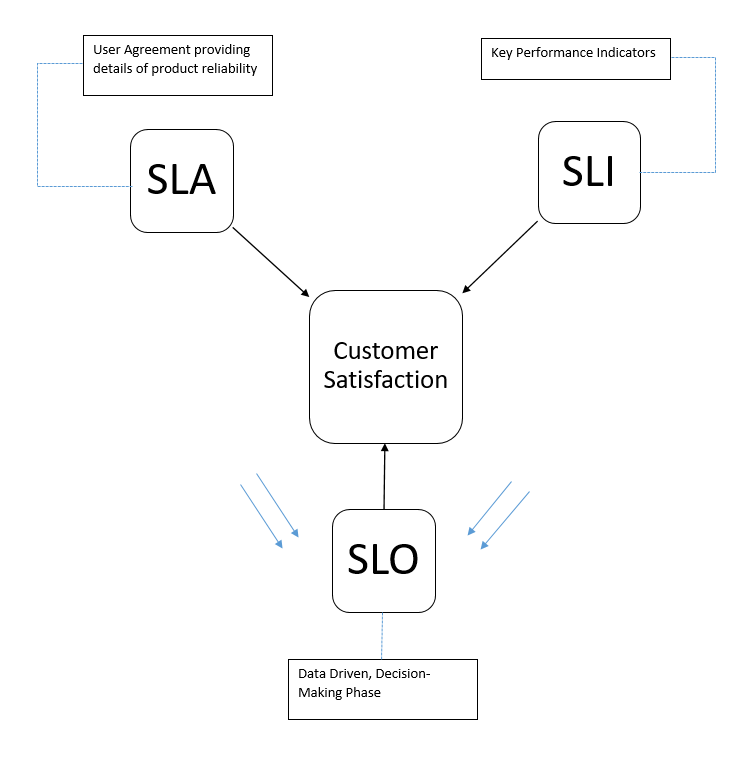Every business desires success. To be successful, they must maintain a standard and a certain degree of expectation in service delivery.
To adhere to these standards, they use Site Reliability Engineering (SRE) and its tool: Service Level Agreements (SLAs), Service Level Objectives (SLOs), and Service Level Indicators (SLIs). These tools define the service delivery to the clients and measure customer satisfaction levels.
This article will discuss SLA Vs. SLO Vs. SLIs, their key differences, advantages, disadvantages, etc.

What is SLA – Service Level Agreement
A service level agreement (SLA) is a contract between a service provider and a customer. It defines the terms and conditions of services and pricing.
An SLA outlines the level of services a client expects from a vendor. Furthermore, it includes the criteria for evaluating services and the penalty conditionals when one side avoids any contract terms and conditions.
For example, when a cloud service provider satisfies the uptime requirement but cannot satisfy the MTTR (Mean Time to Recovery) requirement, you can say that the service provider has satisfied one SLA but violated another.
Service level agreements describe the service parameters in simple language. It specifies crucial measures such as “mean time to recovery (MTTR)” and “means time between failures (MTBF).” Also, they can specify the person responsible for reporting errors or paying associated expenses.
Many top brands, such as Adobe, Microsoft, Amazon Web Services, etc., use SLAs to describe services like guaranteed customer interface availability, anticipated levels of server downtime, and credits clients might anticipate in the event of interruptions.
What is SLO – Service Level Objective
SLO is the level of service dependability the customer wants. It must be feasible and has to be high yet reachable to sustain client satisfaction—the SLO changes with the system.
A percentage represents the SLO success rate. For example, it is not advisable to set it to 100%; a percentage close to that would be more reachable. To determine the SLO, you should measure SLI (service level indicator) metrics from a consumer perspective.
Businesses use SLOs and SLIs to determine key performance indicators (KPIs) to see if performance is declining. They are also used for incident management, particularly for problem-solving as soon as (or even before) issues arise.
While selecting SLOs, identify meaningful SLIs from the user’s perspective.
What Is SLI – Service Level Indicator
Service Level Indicators (SLI) help businesses measure the services they offer to clients. As a result, businesses can identify the area needing focus and accelerate recovery. SLIs are crucial for offering outstanding customer service.
Examples of crucial SLI are site latency, error rate, system throughput, response rate, and other comparable metrics. For example, it identifies differences between the data and the SLO and examines areas that require improvement.
The service level indicator calculates the service availability percentage and determines if the system operates within SLO. Excellent performance is represented by 100%, whereas poor performance is 0%.
Service Level Agreements (SLA) succeed when the target service level is 95%, and the SLI shows a response rate of 96%. If SLI drops below the set SLO, you must increase system availability. In addition, the rate of successful and unsuccessful queries must be measurable to know service dependability.
SLA Vs SLO Vs SLI

#1. SLA
The agreement between a service provider and a client. The service provider promises service delivery, and the client accepts the payment terms. For instance, the service providers can guarantee a minimum monthly uptime of 95% and daily 12-hour response times from their support staff on all days.
All digital users have used SLA, as you gave your consent while browsing a site.
SLAs can cover responding to errors and problems. In addition, the contract can have a penalty clause if one party breaches SLA, such as a refund or a service subscription credit.
Uptime is the most popular SLA metric. This shows if the system uptime is within acceptable limits. If not, service providers can face SLA penalties.
An engineer may set a reasonable SLA to ensure the application’s performance, at its present rate, does not violate any agreements or laws.
#3. SLO
SLOs are the objective to satisfy the SLA. Therefore, SLO is an additional parameter in the SLA. Examples of SLO are the guaranteed 95% uptime or 12-hour response time.
An SLA can define specific SLOs for monitoring. Service providers can also monitor SLO internally.
SLO prevents users from first noticing an increase in latency, which is why SRE (Site Reliability Engineering) teams must monitor performance to prevent them from coming close to violating the SLAs. Some service providers establish and maintain internal baselines higher than the SLA level.
The business reassesses designs to find bottlenecks if the system does not meet benchmarks, engineering teams will set targets to reduce average downtime for the upcoming quarter, and they can establish an internal goal to achieve higher performance.
Businesses can increase the service’s competitiveness by defining more challenging internal performance goals, which can produce higher results than the agreement.
#2. SLI
SLI measures the software services’ behavior using latency and error rate metrics. For example, the number of successful requests in a given duration can be an SLI.
The actual value indicates a specific SLO’s fulfillment. For example, if 98% of the uptime SLO is fulfilled, it is safe to say the SLI of the uptime SLO is 98%, which is the current measurement.
The distinctions between a service level objective (SLO), service level indicator (SLA), and service level agreement (SLA) are crucial to understanding how you use them in actual situations.
SLA, SLO, and SLI Pros
Some pros of these parameters are as follows:
- Businesses can use SLAs to offer different services to clients. For instance, an internet service provider (ISP) may provide data packages with different speeds, megabytes, and price tiers.
- Customers and businesses can benefit from SLOs by clarifying expectations and service conditions. In addition, metrics can demonstrate the success of the clients using SLIs.
SLA, SLO, and SLI Cons
Some cons of these parameters are as follows:
- Sometimes, customers do not understand the SLA terms and conditions and various metrics to measure performance.
- Customers can dispute the services if the SLO is ambiguous. Choosing the appropriate data to gauge SLI goals is not easy.
Tips for Creating SLA, SLO, and SLI
Here are some tips for addressing service-level agreements and their components:
- Pay attention to goals, objectives, and information points. A contract includes promises, goals, and data points to explain conditions and track performance.
- The SLA explains the commitments made to clients. To gain the client’s trust and achieve effective fulfillment, make sure the promises are attainable and realistic.
- Select the right metrics based on the services. All metrics are not equal; some metrics can be more useful. Provide details that assist a customer in understanding the efforts and the indicators that show success.
- Consider how metrics can be helpful to consumers and whether the information is valid.
- Conduct market research and use customer feedback while creating service-level agreements, targets, and indicators.
- Consider the proper service level to offer the client while developing the SLA. Provide the customer with reasonable expectations in line with the team’s skills and system functionalities. Put these predictions in the contract to avoid facing penalties.
Conclusion
SLAs, SLOs, and SLIs are interconnected, and the SLA is the most critical since it binds a service provider and the client. Several SLOs can define the objectives of an SLA, and once you create an SLA, SLOs define the goals. Measuring performance with the SLI lets you know if you have achieved the goal.
